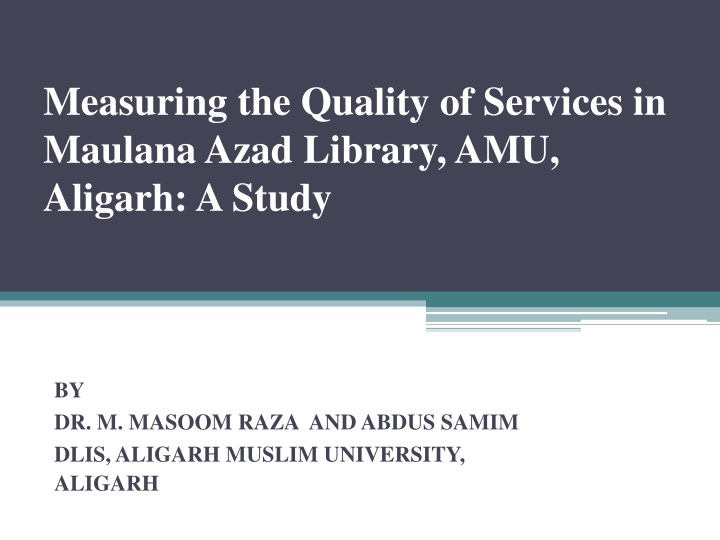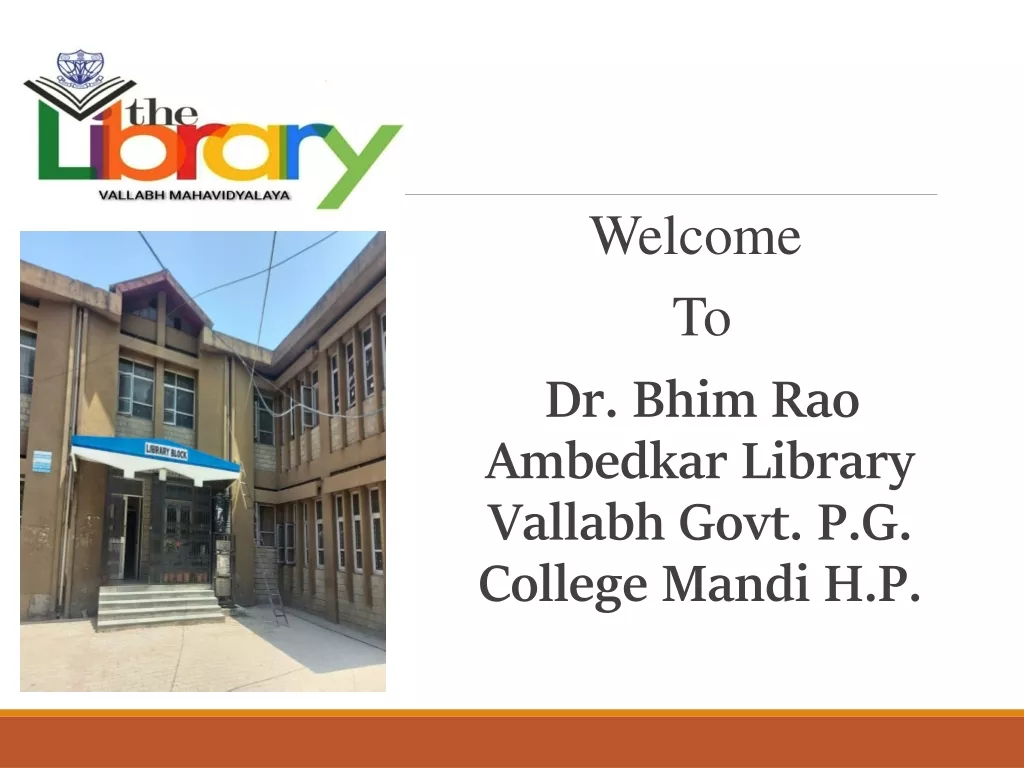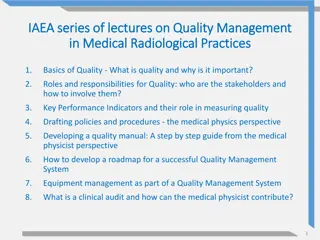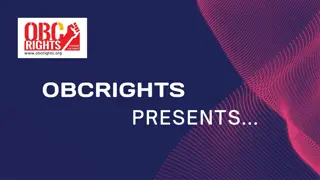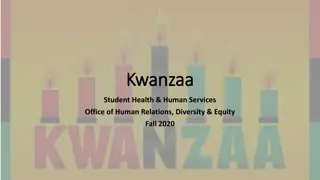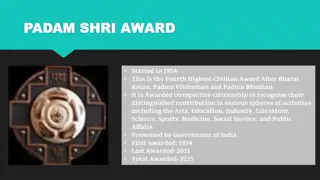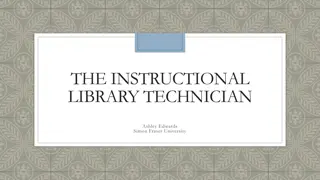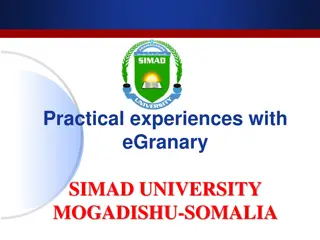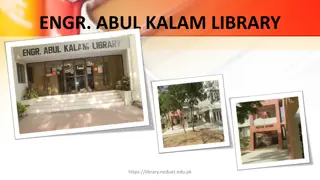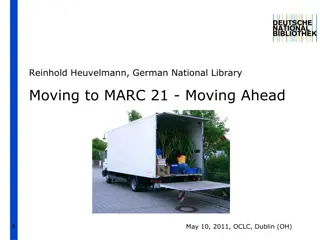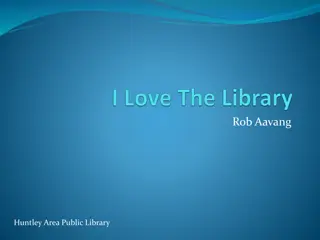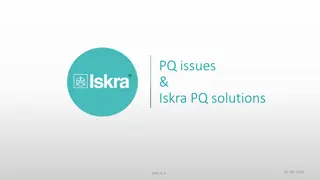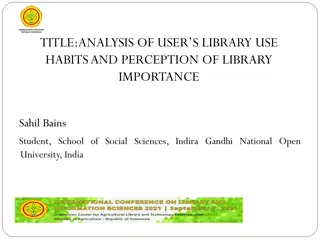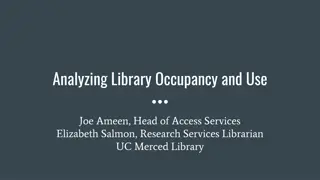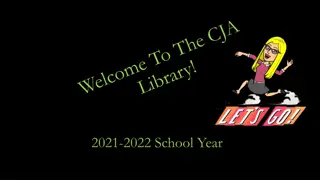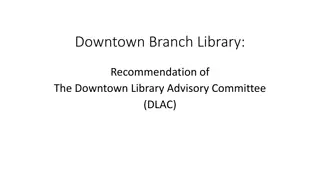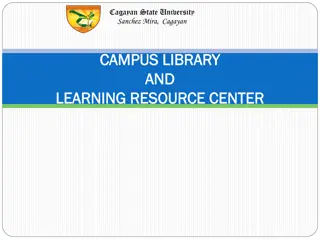Measuring Service Quality in Maulana Azad Library: A Study
This study by Dr. M. Masoom Raza and Abdus Samim DLIS at Aligarh Muslim University focuses on measuring the quality of services in Maulana Azad Library. It delves into dimensions of service quality, predictors of overall service quality, user expectations, problems faced, and general user satisfaction through a well-structured methodology involving a user survey. The data analysis reveals demographic information of users, emphasizing gender distribution and academic classifications.
Download Presentation

Please find below an Image/Link to download the presentation.
The content on the website is provided AS IS for your information and personal use only. It may not be sold, licensed, or shared on other websites without obtaining consent from the author.If you encounter any issues during the download, it is possible that the publisher has removed the file from their server.
You are allowed to download the files provided on this website for personal or commercial use, subject to the condition that they are used lawfully. All files are the property of their respective owners.
The content on the website is provided AS IS for your information and personal use only. It may not be sold, licensed, or shared on other websites without obtaining consent from the author.
E N D
Presentation Transcript
Measuring the Quality of Services in Maulana Azad Library, AMU, Aligarh: A Study BY DR. M. MASOOM RAZA AND ABDUS SAMIM DLIS, ALIGARH MUSLIM UNIVERSITY, ALIGARH
1. INTRODUCTION The storehouses of books and publications to the powerhouses of knowledge and information. A quality service is regarded as one, which satisfies the users' expectation result to an outstanding experience. The actual presence of libraries depends upon users' satisfaction and users are becoming satisfied as soon as the library has the capacity to as much as their expectations or meet the actual needs. Consequently, several libraries and information services have adopted quality management practices in recent years libraries have converted drastically from mere
2. OBJECTIVES OF THE STUDY 1. To distinguish the underlying dimensions of service quality of the Maulana Azad Library, AMU points of views . 2. To determine the best predictors of overall service quality of the MaulanaAzad Library. 3. To understand the users expected quality service from library as well as the problems they faced. 4. To know the degree of general satisfaction of the user through library services. from user
3. METHODOLOGY To determine the service quality factors of the Maulana Azad Library, a user survey was conducted with the help of well established instrument (Libqual+) TM. 22 different service quality attributes were determined which are related to Measuring the quality of services in Maulana Azad Library, AMU, Aligarh: A Study , relevant statements were chosen by the researchers and a established questionnaire was well prepared using the 22 chosen statements for this proposed study. A total of 100 printed questionnaires were distributed among the library users.
4. DATA ANALYSIS AND INTERPRETATION Table 1 - Demographic Information RESPONSE Frequency(N) Percentage(N percentage) 100 100% Distributed 90 90% Collected GENDER 56 62.22% Male 34 37.78% Female AGE 18 20.00% Upto 20 22 24.44% 20-24 years. 35 39.00% 25-34 years. 15 16.66% 34-44 years CLASS 24 26.66% Under Graduation 40 44.44% Post Graduation 26 29.00% Research Scholars 00 00.00% Others
Contd.. A majority of the user respondents 56 (62.22%) were male students and 34 (37.78%) were female students. This gender distribution is as per the proportion of students in the university. A majority of 40 (44.44 %) respondents belongs to Post Graduate Class. Interestingly, there are 26 research Scholars, i.e., (29%) and 24, i.e., (26.66%) respondents are from Under Graduate Courses.
contd.. Table 2: Mean Score for Each Statement. (N 90) S.No ASKED STATEMENT Minimum Service Level 5.01 Desired Service Level Perceived Service Level 1 Employees confidence in user who instil 6.98 3.02 2 Easy-to-use access tools that allow me to find things on my own Print and/or journal collections require for my work Readiness to respond to users questions 4.90 7.03 3.09 3 electronic 6.02 8.02 4.02 I 4 4.68 8.09 5.85 5 Quiet space for individual activities 4.15 8.04 6.26 6 Willingness to help users 5.28 7.89 5.32 7 A comfortable and inviting location 4.28 7.41 6.09 8 Dependability in handling users service problems Giving users individual attention Library space that inspires study and learning 7.21 8.64 5.38 9 4.22 7.63 4.24 10 6.29 8.36 6.35
11 The printed library materials I need for my work 6.63 7.17 6.89 12 Employees who have the knowledge to answer user questions 6.52 8.43 4.12 13 Modern equipment that lets me easily access needed information 5.86 8.12 5.11 14 Employees who are consistently courteous 6.72 7.48 4.2 15 Electronic information resources I need 6.23 8.17 7.45 16 Community space for group learning and group study 5.42 8.34 5.89 17 Employees who deal with users in a caring fashion 5.73 8.22 4.09 18 Making information easily accessible for independent use 5.28 8.02 6.43 19 Employees who understand the needs of their users 6.23 7.28 6.55 20 A getaway for study, learning, or research 5.27 8.56 5.91 21 Making accessible from my home or office electronic resource 5.63 7.45 6.01 22 Availability using resources of online library's help electronic when 6.55 7.42 3.45 my Overall Mean Score 5.64 7.85 5.26 Minimum Mean 5.01 6.98 3.02 Maximum Mean 7.21 8.64 7.45
Perception of Service Quality by the students: 1. Desired and Minimum Quality Service Level The overall desired expectation service was 7.85. Library as a Place has the highest mean score of 6.57, followed by the Information Control mean Score is 6.29 and Affect of service mean score of 6.22. Overall mean score of the Minimum service level is 5.64, desired service level is 7.85 and Perceived service level is 5.26. Dependability in handling users service problems (8.64) as the highest expectation, followed by A gateway for study, learning, or research (8.56), Employees who have the knowledge to answer user questions (8.43) etc.
Contd.. 2. Perceived Quality Service level: As library has the central character for providing quality service to its users. Highest perceived service provided by library as users perspective, such as follows: The Electronic information resources I need (7.45), The printed library materials need for work (6.89), Employees who understand the needs of their users (6.55), Make information easily accessible for independent use (6.43), Library space that inspires study and learning (6.35).
Table - 3. Service Superiority Gap Score Item No. Perceived Service Level Desired Service Level Service Superiority Gap Score 12 4.12 8.43 -4.31 17 4.09 8.22 -4.13 03 4.02 8.02 -4 22 3.45 7.42 -3.97 1 3.02 6.98 -3.96 2 3.09 7.03 -3.94 9 4.24 7.63 -3.39 14 4.2 7.48 -3.28 08 5.38 8.64 -3.26 13 5.11 8.12 -3.01 20 5.91 8.56 -2.65 06 5.32 7.89 -2.57 16 5.89 8.34 -2.45 04 5.85 8.09 -2.24 10 6.35 8.36 -2.01 05 6.25 8.04 -1.78 18 6.43 8.02 -1.59 21 6.01 7.45 -1.44 07 6.09 7.41 -1.32 19 6.55 7.28 -0.73 15 7.45 8.17 -0.72 11 6.89 7.17 -0.28
Contd.. Users of Maulana Azad library ranked affect of service and library as place with a gap score of (-1.92) and serviceeffects with a negative adequacy gap of (-2.61). The large negative superiority gap in all informationcontrol area is ( 2.69) which indicates that the Maulana Azad Library (MAL) is far from meeting its users desired expectations. For the dimension of affect of service the lowest score was observed Employees who have the knowledge to answer user questions (-4.31) and Employees who deal with users in a caring fashion (-4.13). So it was found that Maulana Azad Library is not doing well in the serviceaffects and Library as a place .
Table 4. Service Adequacy Gap Score Statement No. Perceived Service Level Minimum Service Level Service Adequacy Gap Score 5 6.26 4.15 2.11 7 6.09 4.28 1.81 15 7.45 6.23 1.22 4 5.85 4.68 1.17 18 6.43 5.28 1.15 20 5.91 5.27 0.64 16 5.89 5.42 0.47 21 6.01 5.63 0.38 19 6.55 6.23 0.32 11 6.89 6.63 0.26 10 6.35 6.29 0.06 6 5.32 5.28 0.04 9 4.24 4.22 0.02 13 5.11 5.86 -0.75 17 4.09 5.73 -1.64 2 3.09 4.09 -1.81 8 5.38 7.21 -1.83 1 3.02 5.01 -1.99 3 4.02 6.02 -2 12 4.12 6.52 -2.4 14 4.02 6.72 -2.52 22 3.45 6.55 -3.1
Statement 5 Quiet space for individual activities has the highest adequacy gap score of (2.11) that means users are getting their expected service in the very quiet space for individual learning activities and Statement 7 A comfortable and inviting location has positive service adequacy level. A negative service adequacy is also indicated in various statements such as the statement of 22 Availability of online help when using my library's electronic resources has the lowest level of service adequacy level of -3.1 in Maulana Azad library of Aligarh Muslim University.
Zone of Tolerance Fig 4. RADAR CHART of Zone of Tolerance of Maulana Azad Library Service.
Figure 4 depicts the statements which are inside and outside of the Zone of Tolerance. Zone of Tolerance is the distance between minimally-acceptable and desired service levels. Almost all the statements were not in the range with the exception of statement 8 Dependability in handling users service problems , statement11 The printed library materials I need for my work and statement 14 Employees who are consistently courteous . Other statements which were far from the Zone of Tolerance especially those were statements included as: Quiet space for individual activities , A comfortable and inviting location , Giving users individual attention , Employees who have the knowledge to answer user questions , Employees who are consistently courteous , and Employees who deal with users in a caring fashion . These services were far from meeting the users expectations. Not any item was above the desired service level which means no item meet the user s desired expectations.
General Satisfaction Statements and Information Literacy Outcomes Table 5. General Satisfaction Statements and Information Literacy Outcomes. S. NO. Statements Mean Standard Deviation N A. Satisfaction Statements 1 In general, I am satisfied with the way in which I am treated at the Libraries. 6.03 1.46 90 2 In general, I am satisfied with library support for my learning, research, and/or teaching needs 5.28 1.34 90 3 How would you rate the overall quality of the service provided By the library? 5.92 1.42 90 B. Information Literacy Outcomes 1 The library helps me stay new developments in my field(s) of interest or study 5.63 1.11 90 2 The library aids my advancement in my academic discipline 6.02 1.44 90 3 The library enables me to be more efficient in my academic pursuits 5.63 1.2 90 4 The library helps me distinguish untrustworthy information between trustworthy & 6.98 2.16 90 5 The library provides me with the information skills I need in my work or study 5.62 1.15 90
A. Satisfaction Statements From the mean score, it is proved that students are satisfied by the library services; It is found that most of the users are not very much satisfied with the library support for research and learning activities; Overall, the Quality service is relatively good but not outstanding according to the user s perspectives.
B. Information Literacy Outcome Perception. The Table- 5 shows that the users are minimally satisfied with the service rendered by the library to stay informed; The students of Maulana Azad Library are satisfied with the support for academic advancement; The users of the library are satisfied with the academic pursuit rendered by the Maulana Azad Library; The users are highly satisfied in the statement of userssatisfaction in library helped in distinguished untrustworthy information ; Users of the Maulana Azad Library are not highly satisfied in the field of information skills needed by the users between trustworthy and
Conclusion and Recommendation The study result shows that there is a wide gap between user perceptions and expectations of quality service rendered to users by Maulana Azad Library of Aligarh Muslim University. The study showed that students had higher expectations of library service quality. They convenient library employee s help; library staffs had information to meet the queries from students, online help by the library staff etc. The results therefore resulted in negative adequacy gaps and very wide superiority gaps. Though libraries quality service is very good in Quiet space for individual activities , the printed materials as well as electronic materials services available in the library expected
The study recommends that. 1.The library should develop a well designed website which includes all web 2.0 technology. 2.Information literacy programs should be organized by the library for the students and faculty members in different course level at the initial stage of classes. 3.Library employee should hold all the professional and technical knowledge to meet the needs and queries of the users. So that library should organize training programs, workshops for its own employees etc.
